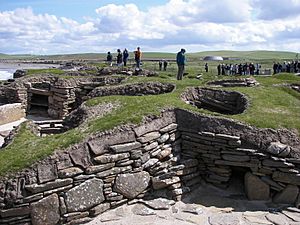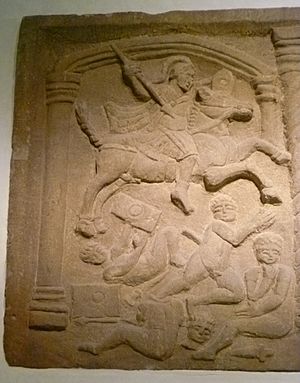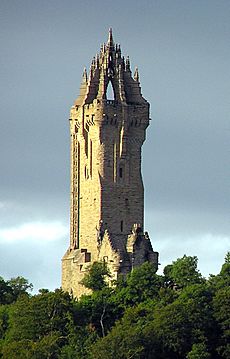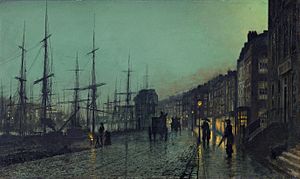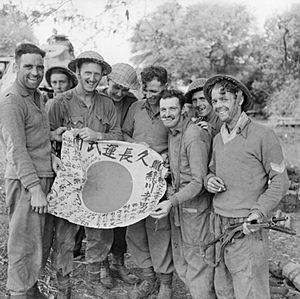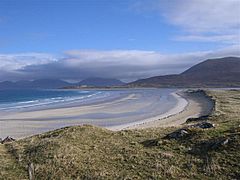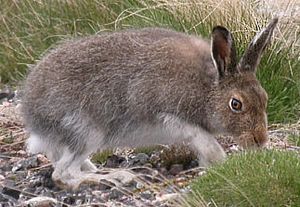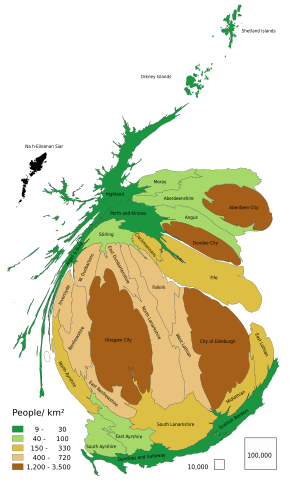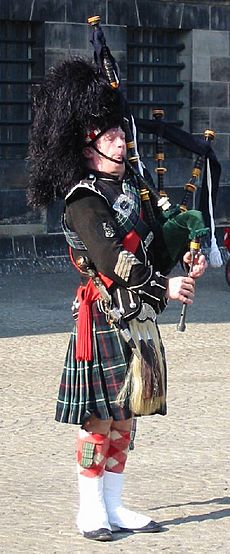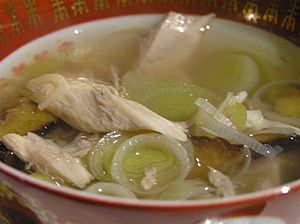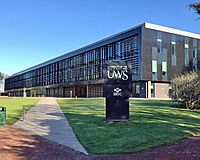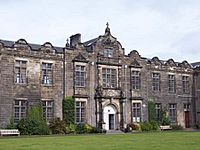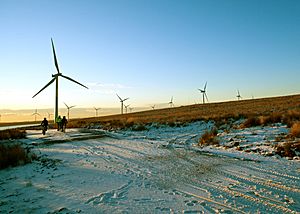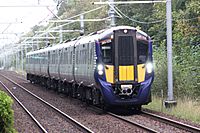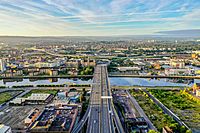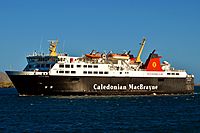Scotland facts for kids
Quick facts for kids
Scotland
|
|
|---|---|
|
Anthem: Various
|
|
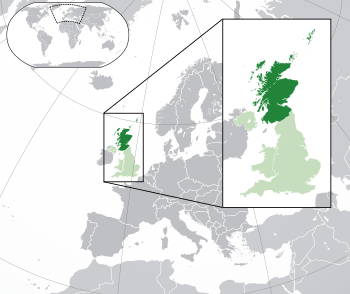
Location of Scotland (dark green)
– on the European continent (green & dark grey) |
|
| Status | Country |
| Capital | Edinburgh 55°57′11″N 3°11′20″W / 55.95306°N 3.18889°W |
| Largest city | Glasgow 55°51′40″N 4°15′00″W / 55.86111°N 4.25000°W |
| Recognised languages | |
| Ethnic groups
(2011)
|
List of ethnicities
96.0% White 2.7% Asian 0.7% Black 0.4% Mixed 0.2% Arab 0.1% other |
| Religion
(2011)
|
53.8% Christianity —32.4% Church of Scotland —15.9% Roman Catholic —5.5% Other Christian 36.7% No religion 1.4% Islam 0.3% Hinduism 0.2% Buddhism 0.2% Sikhism 0.1% Judaism 0.3% Other |
| Demonym(s) |
|
|
|
| Government | Devolved parliamentary legislature within a constitutional monarchy |
|
• Monarch
|
Elizabeth II |
| Nicola Sturgeon | |
|
• Deputy First Minister
|
John Swinney |
| Parliament of the United Kingdom | |
| • Secretary of State | Alister Jack |
| • House of Commons | 59 MPs (of 650) |
| Legislature | Scottish Parliament |
| Formation | |
| 9th century (traditionally 843) | |
| 17 March 1328 | |
| 3 October 1357 | |
| 1 May 1707 | |
|
• Devolution
|
19 November 1998 |
| Area | |
|
• Land
|
77,933 km2 (30,090 sq mi) |
|
• Water (%)
|
3.00% |
| Population | |
|
• 2019 estimate
|
|
|
• 2011 census
|
5,313,600 |
|
• Density
|
67.5/km2 (174.8/sq mi) |
| GDP (nominal) | 2019 estimate |
|
• Total
|
£166 billion ($212B) |
|
• Per capita
|
£30,560 ($39007) |
| HDI (2019) | 0.925 very high · 4th |
| Currency | Pound sterling (GBP; £) |
| Time zone | UTC (Greenwich Mean Time) |
|
• Summer (DST)
|
UTC+1 (British Summer Time) |
| Date format | dd/mm/yyyy (AD) |
| Driving side | left |
| Calling code | +44 |
| ISO 3166 code | GB-SCT |
| Internet TLD | .scot |
Scotland (Scots: Scotland, Scottish Gaelic: Alba) is a country that is part of the United Kingdom. Covering the northern third of the island of Great Britain, mainland Scotland has a 96-mile (154-kilometre) border with England to the southeast and is otherwise surrounded by the Atlantic Ocean to the north and west, the North Sea to the northeast and the Irish Sea to the south. The country also contains more than 790 islands, principally in the archipelagos of the Hebrides and the Northern Isles. Most of the population, including the capital Edinburgh, is concentrated in the Central Belt – the plain between the Scottish Highlands and the Southern Uplands – in the Scottish Lowlands.
Scotland is divided into 32 administrative subdivisions or local authorities, known as council areas. Glasgow City is the largest council area in terms of population, with Highland being the largest in terms of area. Limited self-governing power, covering matters such as education, social services and roads and transportation, is devolved from the Scottish Government to each subdivision. Scotland is the second-largest country in the United Kingdom, and accounted for 8.3% of the population in 2012.
The Kingdom of Scotland emerged as an independent sovereign state in the 9th century and continued to exist until 1707. By inheritance in 1603, James VI of Scotland became king of England and Ireland, thus forming a personal union of the three kingdoms. Scotland subsequently entered into a political union with the Kingdom of England on 1 May 1707 to create the new Kingdom of Great Britain. The union also created the Parliament of Great Britain, which succeeded both the Parliament of Scotland and the Parliament of England. In 1801, the Kingdom of Great Britain entered into a political union with the Kingdom of Ireland to create the United Kingdom of Great Britain and Ireland (in 1922, the Irish Free State seceded from the United Kingdom, leading to the latter being officially renamed the United Kingdom of Great Britain and Northern Ireland in 1927).
Within Scotland, the monarchy of the United Kingdom has continued to use a variety of styles, titles and other royal symbols of statehood specific to the pre-union Kingdom of Scotland. The legal system within Scotland has also remained separate from those of England and Wales and Northern Ireland; Scotland constitutes a distinct jurisdiction in both public and private law. The continued existence of legal, educational, religious and other institutions distinct from those in the remainder of the UK have all contributed to the continuation of Scottish culture and national identity since the 1707 incorporating union with England.
In 1999, a Scottish Parliament was re-established, in the form of a devolved unicameral legislature comprising 129 members, having authority over many areas of domestic policy. The head of the Scottish Government is the first minister of Scotland, who is supported by the deputy first minister of Scotland. Scotland is represented in the United Kingdom Parliament by 59 MPs. Scotland is also a member of the British–Irish Council, sending five members of the Scottish Parliament to the British–Irish Parliamentary Assembly, as well as being part of the Joint Ministerial Committee, represented by the first minister.
History
Early history
Repeated glaciations, which covered the entire land mass of modern Scotland, destroyed any traces of human habitation that may have existed before the Mesolithic period. It is believed the first post-glacial groups of hunter-gatherers arrived in Scotland around 12,800 years ago, as the ice sheet retreated after the last glaciation.
The groups of settlers began building the first known permanent houses on Scottish soil around 9,500 years ago, and the first villages around 6,000 years ago. The well-preserved village of Skara Brae on the mainland of Orkney dates from this period. Neolithic habitation, burial and ritual sites are particularly common and well preserved in the Northern Isles and Western Isles, where a lack of trees led to most structures being built of local stone.
The 2009 discovery in Scotland of a 4000-year-old tomb with burial treasures at Forteviot, near Perth, the capital of a Pictish Kingdom in the 8th and 9th centuries AD, is unrivalled anywhere in Britain. It contains the remains of an early Bronze Age ruler laid out on white quartz pebbles and birch bark. It was also discovered for the first time that early Bronze Age people placed flowers in their graves.
Scotland may have been part of a Late Bronze Age maritime trading culture called the Atlantic Bronze Age, which included other Celtic nations, and the areas that became England, France, Spain, and Portugal.
In the winter of 1850, a severe storm hit Scotland, causing widespread damage and over 200 deaths. In the Bay of Skaill, the storm stripped the earth from a large irregular knoll, known as "Skerrabra". When the storm cleared, local villagers found the outline of a village, consisting of a number of small houses without roofs. William Watt of Skaill, the local laird, began an amateur excavation of the site, but after uncovering four houses, the work was abandoned in 1868. The site remained undisturbed until 1913, when during a single weekend the site was plundered by a party with shovels who took away an unknown quantity of artefacts. In 1924, another storm swept away part of one of the houses and it was determined the site should be made secure and more seriously investigated. The job was given to University of Edinburgh's Professor Vere Gordon Childe who travelled to Skara Brae for the first time in mid-1927.
Roman influence
The written protohistory of Scotland began with the arrival of the Roman Empire in southern and central Great Britain, when the Romans occupied what is now England and Wales, administering it as a province called Britannia. Roman invasions and occupations of southern Scotland were a series of brief interludes.
According to the Roman historian Tacitus, the Caledonians "turned to armed resistance on a large scale", attacking Roman forts and skirmishing with their legions. In a surprise night-attack, the Caledonians very nearly wiped out the whole 9th Legion until it was saved by Agricola's cavalry.
In AD 83–84, the General Gnaeus Julius Agricola defeated the Caledonians at the Battle of Mons Graupius. Tacitus wrote that, before the battle, the Caledonian leader, Calgacus, gave a rousing speech in which he called his people the "last of the free" and accused the Romans of "making the world a desert and calling it peace" (freely translated). After the Roman victory, Roman forts were briefly set along the Gask Ridge close to the Highland line (only Cawdor near Inverness is known to have been constructed beyond that line). Three years after the battle, the Roman armies had withdrawn to the Southern Uplands.
The Romans erected Hadrian's Wall to control tribes on both sides of the wall so the Limes Britannicus became the northern border of the Roman Empire; although the army held the Antonine Wall in the Central Lowlands for two short periods – the last during the reign of Emperor Septimius Severus from 208 until 210.
The Roman military occupation of a significant part of what is now northern Scotland lasted only about 40 years; although their influence on the southern section of the country, occupied by Brythonic tribes such as the Votadini and Damnonii, would still have been considerable between the first and fifth centuries. The Welsh term Hen Ogledd ("Old North") is used by scholars to describe what is now the North of England and the South of Scotland during its habitation by Brittonic-speaking people around AD 500 to 800. According to writings from the 9th and 10th centuries, the Gaelic kingdom of Dál Riata was founded in the 6th century in western Scotland. The 'traditional' view is that settlers from Ireland founded the kingdom, bringing Gaelic language and culture with them. However, some archaeologists have argued against this view, saying there is no archaeological or placename evidence for a migration or a takeover by a small group of elites.
Middle Ages
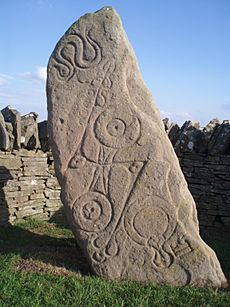
The Kingdom of the Picts (based in Fortriu by the 6th century) was the state that eventually became known as "Alba" or "Scotland". The development of "Pictland", according to the historical model developed by Peter Heather, was a natural response to Roman imperialism. Another view places emphasis on the Battle of Dun Nechtain, and the reign of Bridei m. Beli (671–693), with another period of consolidation in the reign of Óengus mac Fergusa (732–761).
The Kingdom of the Picts as it was in the early 8th century, when Bede was writing, was largely the same as the kingdom of the Scots in the reign of Alexander I (1107–1124). However, by the tenth century, the Pictish kingdom was dominated by what we can recognise as Gaelic culture, and had developed a traditional story of an Irish conquest around the ancestor of the contemporary royal dynasty, Cináed mac Ailpín (Kenneth MacAlpin).
From a base of territory in eastern Scotland north of the River Forth and south of the River Oykel, the kingdom acquired control of the lands lying to the north and south. By the 12th century, the kings of Alba had added to their territories the English-speaking land in the south-east and attained overlordship of Gaelic-speaking Galloway and Norse-speaking Caithness; by the end of the 13th century, the kingdom had assumed approximately its modern borders. However, processes of cultural and economic change beginning in the 12th century ensured Scotland looked very different in the later Middle Ages.
The push for this change was the reign of David I and the Davidian Revolution. Feudalism, government reorganisation and the first legally recognised towns (called burghs) began in this period. These institutions and the immigration of French and Anglo-French knights and churchmen facilitated cultural osmosis, whereby the culture and language of the low-lying and coastal parts of the kingdom's original territory in the east became, like the newly acquired south-east, English-speaking, while the rest of the country retained the Gaelic language, apart from the Northern Isles of Orkney and Shetland, which remained under Norse rule until 1468. The Scottish state entered a largely successful and stable period between the 12th and 14th centuries, there was relative peace with England, trade and educational links were well developed with the Continent and at the height of this cultural flowering John Duns Scotus was one of Europe's most important and influential philosophers.
The death of Alexander III in March 1286, followed by that of his granddaughter Margaret, Maid of Norway, broke the centuries-old succession line of Scotland's kings and shattered the 200-year golden age that began with David I. Edward I of England was asked to arbitrate between claimants for the Scottish crown, and he organised a process known as the Great Cause to identify the most legitimate claimant. John Balliol was pronounced king in the Great Hall of Berwick Castle on 17 November 1292 and inaugurated at Scone on 30 November, St. Andrew's Day. Edward I, who had coerced recognition as Lord Paramount of Scotland, the feudal superior of the realm, steadily undermined John's authority. In 1294, Balliol and other Scottish lords refused Edward's demands to serve in his army against the French. Instead the Scottish parliament sent envoys to France to negotiate an alliance. Scotland and France sealed a treaty on 23 October 1295, known as the Auld Alliance (1295–1560). War ensued and King John was deposed by Edward who took personal control of Scotland. Andrew Moray and William Wallace initially emerged as the principal leaders of the resistance to English rule in what became known as the Wars of Scottish Independence (1296–1328).
The nature of the struggle changed significantly when Robert the Bruce, Earl of Carrick, killed his rival John Comyn on 10 February 1306 at Greyfriars Kirk in Dumfries. He was crowned king (as Robert I) less than seven weeks later. Robert I battled to restore Scottish Independence as King for over 20 years, beginning by winning Scotland back from the Norman English invaders piece by piece. Victory at the Battle of Bannockburn in 1314 proved the Scots had regained control of their kingdom. In 1315, Edward Bruce, brother of the King, was briefly appointed High King of Ireland during an ultimately unsuccessful Scottish invasion of Ireland aimed at strengthening Scotland's position in its wars against England. In 1320 the world's first documented declaration of independence, the Declaration of Arbroath, won the support of Pope John XXII, leading to the legal recognition of Scottish sovereignty by the English Crown.
However, war with England continued for several decades after the death of Bruce. A civil war between the Bruce dynasty and their long-term Comyn-Balliol rivals lasted until the middle of the 14th century. Although the Bruce dynasty was successful, David II's lack of an heir allowed his half-nephew Robert II to come to the throne and establish the Stewart Dynasty. The Stewarts ruled Scotland for the remainder of the Middle Ages. The country they ruled experienced greater prosperity from the end of the 14th century through the Scottish Renaissance to the Reformation. This was despite continual warfare with England, the increasing division between Highlands and Lowlands, and a large number of royal minorities.
This period was the height of the Franco-Scottish alliance. The Scots Guard – la Garde Écossaise – was founded in 1418 by Charles VII of France. The Scots soldiers of the Garde Écossaise fought alongside Joan of Arc against England during the Hundred Years War. In March 1421, a Franco-Scots force under John Stewart, 2nd Earl of Buchan, and Gilbert de Lafayette, defeated a larger English army at the Battle of Baugé. Three years later, at the Battle of Verneuil, the French and Scots lost around 7000 men. The Scottish intervention contributed to France's victory in the war.
Early modern era
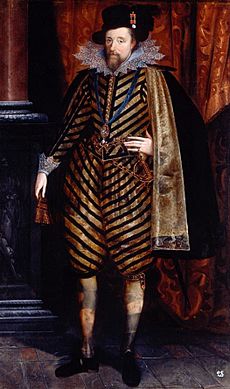
In 1502, James IV of Scotland signed the Treaty of Perpetual Peace with Henry VII of England. He also married Henry's daughter, Margaret Tudor, setting the stage for the Union of the Crowns. For Henry, the marriage into one of Europe's most established monarchies gave legitimacy to the new Tudor royal line. A decade later, James made the fateful decision to invade England in support of France under the terms of the Auld Alliance. He was the last British monarch to die in battle, at the Battle of Flodden. Within a generation the Auld Alliance was ended by the Treaty of Edinburgh. France agreed to withdraw all land and naval forces. In the same year, 1560, John Knox realised his goal of seeing Scotland become a Protestant nation and the Scottish parliament revoke papal authority in Scotland. Mary, Queen of Scots, a Catholic and former queen of France, was forced to abdicate in 1567.
In 1603, James VI, King of Scots inherited the thrones of the Kingdom of England and the Kingdom of Ireland, and became King James I of England and Ireland, and left Edinburgh for London. With the exception of a short period under the Protectorate, Scotland remained a separate state, but there was considerable conflict between the crown and the Covenanters over the form of church government. The Glorious Revolution of 1688–89 saw the overthrow of King James VII of Scotland and II of England by the English Parliament in favour of William and Mary.
In common with countries such as France, Norway, Sweden and Finland, Scotland experienced famines during the 1690s. Mortality, reduced childbirths and increased emigration reduced the population of parts of the country by between 10 and 15 per cent.
In 1698, the Company of Scotland attempted project to secure a trading colony on the Isthmus of Panama. Almost every Scottish landowner who had money to spare is said to have invested in the Darien scheme. Its failure bankrupted these landowners, but not the burghs. Nevertheless, the nobles' bankruptcy, along with the threat of an English invasion, played a leading role in convincing the Scots elite to back a union with England.
On 22 July 1706, the Treaty of Union was agreed between representatives of the Scots Parliament and the Parliament of England and the following year twin Acts of Union were passed by both parliaments to create the united Kingdom of Great Britain with effect from 1 May 1707.
18th century
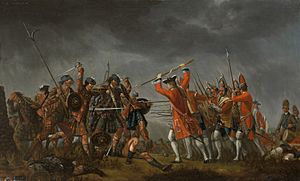
With trade tariffs with England now abolished, trade blossomed, especially with Colonial America. The clippers belonging to the Glasgow Tobacco Lords were the fastest ships on the route to Virginia. Until the American War of Independence in 1776, Glasgow was the world's premier tobacco port, dominating world trade. The disparity between the wealth of the merchant classes of the Scottish Lowlands and the ancient clans of the Scottish Highlands grew, amplifying centuries of division.
The deposed Jacobite Stuart claimants had remained popular in the Highlands and north-east, particularly amongst non-Presbyterians, including Roman Catholics and Episcopalian Protestants. However, two major Jacobite Risings launched in 1715 and 1745 failed to remove the House of Hanover from the British throne. The threat of the Jacobite movement to the United Kingdom and its monarchs effectively ended at the Battle of Culloden, Great Britain's last pitched battle. This defeat paved the way for large-scale removals of the indigenous populations of the Highlands and Islands, known as the Highland Clearances.
The Scottish Enlightenment and the Industrial Revolution made Scotland into an intellectual, commercial and industrial powerhouse–so much so Voltaire said "We look to Scotland for all our ideas of civilisation." With the demise of Jacobitism and the advent of the Union, thousands of Scots, mainly Lowlanders, took up numerous positions of power in politics, civil service, the army and navy, trade, economics, colonial enterprises and other areas across the nascent British Empire. Historian Neil Davidson notes "after 1746 there was an entirely new level of participation by Scots in political life, particularly outside Scotland." Davidson also states "far from being 'peripheral' to the British economy, Scotland – or more precisely, the Lowlands – lay at its core."
19th century
The Scottish Reform Act 1832 increased the number of Scottish MPs and widened the franchise to include more of the middle classes. From the mid-century there were increasing calls for Home Rule for Scotland and the post of Secretary of State for Scotland was revived. Towards the end of the century Prime Ministers of Scottish descent included William E. Gladstone, and the Earl of Rosebery. In the later 19th century the growing importance of the working classes was marked by Keir Hardie's success in the Mid Lanarkshire by-election, 1888, leading to the foundation of the Scottish Labour Party, which was absorbed into the Independent Labour Party in 1895, with Hardie as its first leader.
Glasgow became one of the largest cities in the world, and known as "the Second City of the Empire" after London. After 1860 the Clydeside shipyards specialised in steamships made of iron (after 1870, made of steel), which rapidly replaced the wooden sailing vessels of both the merchant fleets and the battle fleets of the world. It became the world's pre-eminent shipbuilding centre. The industrial developments, while they brought work and wealth, were so rapid that housing, town-planning, and provision for public health did not keep pace with them, and for a time living conditions in some of the towns and cities were notoriously bad, with overcrowding, high infant mortality, and growing rates of tuberculosis.
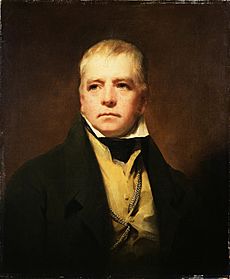
While the Scottish Enlightenment is traditionally considered to have concluded toward the end of the 18th century, disproportionately large Scottish contributions to British science and letters continued for another 50 years or more, thanks to such figures as the physicists James Clerk Maxwell and Lord Kelvin, and the engineers and inventors James Watt and William Murdoch, whose work was critical to the technological developments of the Industrial Revolution throughout Britain. In literature the most successful figure of the mid-19th century was Walter Scott. His first prose work, Waverley in 1814, is often called the first historical novel. It launched a highly successful career that probably more than any other helped define and popularise Scottish cultural identity. In the late 19th century, a number of Scottish-born authors achieved international reputations, such as Robert Louis Stevenson, Arthur Conan Doyle, J. M. Barrie and George MacDonald. Scotland also played a major part in the development of art and architecture. The Glasgow School, which developed in the late 19th century, and flourished in the early 20th century, produced a distinctive blend of influences including the Celtic Revival the Arts and Crafts Movement, and Japonisme, which found favour throughout the modern art world of continental Europe and helped define the Art Nouveau style. Proponents included architect and artist Charles Rennie Mackintosh.
This period saw a process of rehabilitation for Highland culture. In the 1820s, as part of the Romantic revival, tartan and the kilt were adopted by members of the social elite, not just in Scotland, but across Europe, prompted by the popularity of Macpherson's Ossian cycle and then Walter Scott's Waverley novels. However, the Highlands remained very poor and traditional. The desire to improve agriculture and profits led to the Highland Clearances, in which much of the population of the Highlands suffered forced displacement as lands were enclosed, principally so that they could be used for sheep farming. The clearances followed patterns of agricultural change throughout Britain, but were particularly notorious as a result of the late timing, the lack of legal protection for year-by-year tenants under Scots law, the abruptness of the change from the traditional clan system, and the brutality of many evictions. One result was a continuous exodus from the land—to the cities, or further afield to England, Canada, America or Australia. The population of Scotland grew steadily in the 19th century, from 1,608,000 in the census of 1801 to 2,889,000 in 1851 and 4,472,000 in 1901. Even with the development of industry there were not enough good jobs. As a result, during the period 1841–1931, about 2 million Scots migrated to North America and Australia, and another 750,000 Scots relocated to England.

After prolonged years of struggle in the Kirk, in 1834 the Evangelicals gained control of the General Assembly and passed the Veto Act, which allowed congregations to reject unwanted "intrusive" presentations to livings by patrons. The following "Ten Years' Conflict" of legal and political wrangling ended in defeat for the non-intrusionists in the civil courts. The result was a schism from the church by some of the non-intrusionists led by Dr Thomas Chalmers, known as the Great Disruption of 1843. Roughly a third of the clergy, mainly from the North and Highlands, formed the separate Free Church of Scotland. In the late 19th century growing divisions between fundamentalist Calvinists and theological liberals resulted in a further split in the Free Church as the rigid Calvinists broke away to form the Free Presbyterian Church in 1893. Catholic Emancipation in 1829 and the influx of large numbers of Irish immigrants, particularly after the famine years of the late 1840s, mainly to the growing lowland centres like Glasgow, led to a transformation in the fortunes of Catholicism. In 1878, despite opposition, a Roman Catholic ecclesiastical hierarchy was restored to the country, and Catholicism became a significant denomination within Scotland.
Industrialisation, urbanisation and the Disruption of 1843 all undermined the tradition of parish schools. From 1830 the state began to fund buildings with grants; then from 1846 it was funding schools by direct sponsorship; and in 1872 Scotland moved to a system like that in England of state-sponsored largely free schools, run by local school boards. The historic University of Glasgow became a leader in British higher education by providing the educational needs of youth from the urban and commercial classes, as opposed to the upper class. The University of St Andrews pioneered the admission of women to Scottish universities. From 1892 Scottish universities could admit and graduate women and the numbers of women at Scottish universities steadily increased until the early 20th century.
Early 20th century
Scotland played a major role in the British effort in the First World War. It especially provided manpower, ships, machinery, fish and money. With a population of 4.8 million in 1911, Scotland sent over half a million men to the war, of whom over a quarter died in combat or from disease, and 150,000 were seriously wounded. Field Marshal Sir Douglas Haig was Britain's commander on the Western Front.
The war saw the emergence of a radical movement called "Red Clydeside" led by militant trades unionists. Formerly a Liberal stronghold, the industrial districts switched to Labour by 1922, with a base among the Irish Catholic working class districts. Women were especially active in building neighbourhood solidarity on housing issues. However, the "Reds" operated within the Labour Party and had little influence in Parliament and the mood changed to passive despair by the late 1920s.
The shipbuilding industry expanded by a third and expected renewed prosperity, but instead a serious depression hit the economy by 1922 and it did not fully recover until 1939. The interwar years were marked by economic stagnation in rural and urban areas, and high unemployment. Indeed, the war brought with it deep social, cultural, economic, and political dislocations. Thoughtful Scots pondered their declension, as the main social indicators such as poor health, bad housing, and long-term mass unemployment, pointed to terminal social and economic stagnation at best, or even a downward spiral. Service abroad on behalf of the Empire lost its allure to ambitious young people, who left Scotland permanently. The heavy dependence on obsolescent heavy industry and mining was a central problem, and no one offered workable solutions. The despair reflected what Finlay (1994) describes as a widespread sense of hopelessness that prepared local business and political leaders to accept a new orthodoxy of centralised government economic planning when it arrived during the Second World War.
The Second World War brought renewed prosperity, despite extensive bombing of cities by the Luftwaffe. It saw the invention of radar by Robert Watson-Watt, which was invaluable in the Battle of Britain as was the leadership at RAF Fighter Command of Air Chief Marshal Sir Hugh Dowding.
Post-World War II

After 1945, Scotland's economic situation became progressively worse due to overseas competition, inefficient industry, and industrial disputes. Only in recent decades has the country enjoyed something of a cultural and economic renaissance. Economic factors contributing to this recovery include a resurgent financial services industry, electronics manufacturing, (see Silicon Glen), and the North Sea oil and gas industry. The introduction in 1989 by Margaret Thatcher's government of the Community Charge (widely known as the Poll Tax) one year before the rest of the United Kingdom, contributed to a growing movement for a return to direct Scottish control over domestic affairs. Following a referendum on devolution proposals in 1997, the Scotland Act 1998 was passed by the United Kingdom Parliament to establish a devolved Scottish Parliament and Scottish Government with responsibility for most laws specific to Scotland.
Geography and natural history
The mainland of Scotland comprises the northern third of the land mass of the island of Great Britain, which lies off the north-west coast of Continental Europe. The total area is 78,772 km2 (30,414 sq mi)*, comparable to the size of the Czech Republic. Scotland's only land border is with England, and runs for 96 kilometres (60 mi)* between the basin of the River Tweed on the east coast and the Solway Firth in the west. The Atlantic Ocean borders the west coast and the North Sea is to the east. The island of Ireland lies only 21 kilometres (13 mi)* from the south-western peninsula of Kintyre; Norway is 305 kilometres (190 mi)* to the east and the Faroes, 270 kilometres (168 mi)* to the north.
The territorial extent of Scotland is generally that established by the 1237 Treaty of York between Scotland and the Kingdom of England and the 1266 Treaty of Perth between Scotland and Norway. Important exceptions include the Isle of Man, which having been lost to England in the 14th century is now a crown dependency outside of the United Kingdom; the island groups Orkney and Shetland, which were acquired from Norway in 1472; and Berwick-upon-Tweed, lost to England in 1482.
The geographical centre of Scotland lies a few miles from the village of Newtonmore in Badenoch. Rising to 1,344 metres (4,409 ft)* above sea level, Scotland's highest point is the summit of Ben Nevis, in Lochaber, while Scotland's longest river, the River Tay, flows for a distance of 190 kilometres (118 mi)*.
Geology and geomorphology
The whole of Scotland was covered by ice sheets during the Pleistocene ice ages and the landscape is much affected by glaciation. From a geological perspective, the country has three main sub-divisions.
The Highlands and Islands lie to the north and west of the Highland Boundary Fault, which runs from Arran to Stonehaven. This part of Scotland largely comprises ancient rocks from the Cambrian and Precambrian, which were uplifted during the later Caledonian Orogeny. It is interspersed with igneous intrusions of a more recent age, remnants of which formed mountain massifs such as the Cairngorms and Skye Cuillins.
A significant exception to the above are the fossil-bearing beds of Old Red Sandstones found principally along the Moray Firth coast. The Highlands are generally mountainous and the highest elevations in the British Isles are found here. Scotland has over 790 islands divided into four main groups: Shetland, Orkney, and the Inner Hebrides and Outer Hebrides. There are numerous bodies of freshwater including Loch Lomond and Loch Ness. Some parts of the coastline consist of machair, a low lying dune pasture land.
The Central Lowlands is a rift valley mainly comprising Paleozoic formations. Many of these sediments have economic significance for it is here that the coal and iron bearing rocks that fuelled Scotland's industrial revolution are found. This area has also experienced intense volcanism, Arthur's Seat in Edinburgh being the remnant of a once much larger volcano. This area is relatively low-lying, although even here hills such as the Ochils and Campsie Fells are rarely far from view.
The Southern Uplands are a range of hills almost 200 kilometres (124 mi)* long, interspersed with broad valleys. They lie south of a second fault line (the Southern Uplands fault) that runs from Girvan to Dunbar. The geological foundations largely comprise Silurian deposits laid down some 4–500 million years ago. The high point of the Southern Uplands is Merrick with an elevation of 843 m (2,766 ft)*. The Southern Uplands is home to the UK's highest village, Wanlockhead (430 m or 1,411 ft above sea level).
Climate
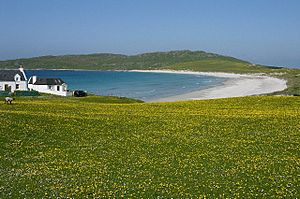
The climate of Scotland is temperate and oceanic, and tends to be very changeable. As it is warmed by the Gulf Stream from the Atlantic, it has much milder winters (but cooler, wetter summers) than areas on similar latitudes, such as Labrador, southern Scandinavia, the Moscow region in Russia, and the Kamchatka Peninsula on the opposite side of Eurasia. However, temperatures are generally lower than in the rest of the UK, with the coldest ever UK temperature of −27.2 °C (−17.0 °F) recorded at Braemar in the Grampian Mountains, on 11 February 1895. Winter maxima average 6 °C (42.8 °F) in the Lowlands, with summer maxima averaging 18 °C (64.4 °F). The highest temperature recorded was 32.9 °C (91.2 °F) at Greycrook, Scottish Borders on 9 August 2003.
The west of Scotland is usually warmer than the east, owing to the influence of Atlantic ocean currents and the colder surface temperatures of the North Sea. Tiree, in the Inner Hebrides, is one of the sunniest places in the country: it had more than 300 hours of sunshine in May 1975. Rainfall varies widely across Scotland. The western highlands of Scotland are the wettest, with annual rainfall in a few places exceeding 3,000 mm (118.1 in)*. In comparison, much of lowland Scotland receives less than 800 mm (31.5 in)* annually. Heavy snowfall is not common in the lowlands, but becomes more common with altitude. Braemar has an average of 59 snow days per year, while many coastal areas average fewer than 10 days of lying snow per year.
Flora and fauna
Scotland's wildlife is typical of the north-west of Europe, although several of the larger mammals such as the lynx, brown bear, wolf, elk and walrus were hunted to extinction in historic times. There are important populations of seals and internationally significant nesting grounds for a variety of seabirds such as gannets. The golden eagle is something of a national icon.
On the high mountain tops, species including ptarmigan, mountain hare and stoat can be seen in their white colour phase during winter months. Remnants of the native Scots pine forest exist and within these areas the Scottish crossbill, the UK's only endemic bird species and vertebrate, can be found alongside capercaillie, wildcat, red squirrel and pine marten. Various animals have been re-introduced, including the white-tailed sea eagle in 1975, the red kite in the 1980s, and there have been experimental projects involving the beaver and wild boar. Today, much of the remaining native Caledonian Forest lies within the Cairngorms National Park and remnants of the forest remain at 84 locations across Scotland. On the west coast, remnants of ancient Celtic Rainforest still remain, particularly on the Taynish peninsula in Argyll, these forests are particularly rare due to high rates of deforestation throughout Scottish history.
The flora of the country is varied incorporating both deciduous and coniferous woodland and moorland and tundra species. However, large scale commercial tree planting and the management of upland moorland habitat for the grazing of sheep and commercial field sport activities impacts upon the distribution of indigenous plants and animals. The UK's tallest tree is a grand fir planted beside Loch Fyne, Argyll in the 1870s, and the Fortingall Yew may be 5,000 years old and is probably the oldest living thing in Europe. Although the number of native vascular plants is low by world standards, Scotland's substantial bryophyte flora is of global importance.
Demographics
The population of Scotland at the 2001 Census was 5,062,011. This rose to 5,295,400, the highest ever, at the 2011 Census. The most recent ONS estimate, for mid-2019, was 5,463,300.
In the 2011 Census, 62% of Scotland's population stated their national identity as 'Scottish only', 18% as 'Scottish and British', 8% as 'British only', and 4% chose 'other identity only'.
Although Edinburgh is the capital of Scotland, the largest city is Glasgow, which has just over 584,000 inhabitants. The Greater Glasgow conurbation, with a population of almost 1.2 million, is home to nearly a quarter of Scotland's population. The Central Belt is where most of the main towns and cities are located, including Glasgow, Edinburgh, Dundee, and Perth. Scotland's only major city outside the Central Belt is Aberdeen. The Scottish Lowlands host 80% of the total population, where the Central Belt accounts for 3.5 million people.
In general, only the more accessible and larger islands remain inhabited. Currently, fewer than 90 remain inhabited. The Southern Uplands are essentially rural in nature and dominated by agriculture and forestry. Because of housing problems in Glasgow and Edinburgh, five new towns were designated between 1947 and 1966. They are East Kilbride, Glenrothes, Cumbernauld, Livingston, and Irvine.
Immigration since World War II has given Glasgow, Edinburgh, and Dundee small South Asian communities. In 2011, there were an estimated 49,000 ethnically Pakistani people living in Scotland, making them the largest non-White ethnic group. Since the enlargement of the European Union more people from Central and Eastern Europe have moved to Scotland, and the 2011 census indicated that 61,000 Poles live there.
Scotland has three officially recognised languages: English, Scots, and Scottish Gaelic. Scottish Standard English, a variety of English as spoken in Scotland, is at one end of a bipolar linguistic continuum, with broad Scots at the other. Scottish Standard English may have been influenced to varying degrees by Scots. The 2011 census indicated that 63% of the population had "no skills in Scots". Others speak Highland English. Gaelic is mostly spoken in the Western Isles, where a large proportion of people still speak it. Nationally, its use is confined to 1% of the population. The number of Gaelic speakers in Scotland dropped from 250,000 in 1881 to 60,000 in 2008.
There are many more people with Scottish ancestry living abroad than the total population of Scotland. In the 2000 Census, 9.2 million Americans self-reported some degree of Scottish descent. Ulster's Protestant population is mainly of lowland Scottish descent, and it is estimated that there are more than 27 million descendants of the Scots-Irish migration now living in the US. In Canada, the Scottish-Canadian community accounts for 4.7 million people. About 20% of the original European settler population of New Zealand came from Scotland.
In August 2012, the Scottish population reached an all-time high of 5.25 million people. The reasons given were that, in Scotland, births were outnumbering the number of deaths, and immigrants were moving to Scotland from overseas. In 2011, 43,700 people moved from Wales, Northern Ireland or England to live in Scotland.
The total fertility rate (TFR) in Scotland is below the replacement rate of 2.1 (the TFR was 1.73 in 2011). The majority of births are to unmarried women (51.3% of births were outside of marriage in 2012).
Life expectancy for those born in Scotland between 2012 and 2014 is 77.1 years for males and 81.1 years for females. This is the lowest of any of the four countries of the UK.
|
Largest cities or towns in Scotland
Scotland's Census 2011 |
||
|---|---|---|
| Rank | Name | Pop. |
| 1 | Glasgow | 590,507 |
| 2 | Edinburgh | 459,366 |
| 3 | Aberdeen | 195,021 |
| 4 | Dundee | 147,285 |
| 5 | Paisley | 76,834 |
| 6 | East Kilbride | 74,395 |
| 7 | Livingston | 56,269 |
| 8 | Hamilton | 53,188 |
| 9 | Cumbernauld | 52,270 |
| 10 | Kirkcaldy | 49,709 |
Religion
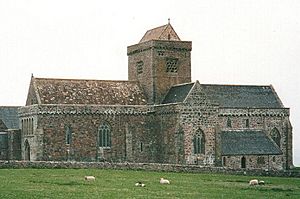
Just over half (54%) of the Scottish population reported being a Christian while nearly 37% reported not having a religion in a 2011 census. Since the Scottish Reformation of 1560, the national church (the Church of Scotland, also known as The Kirk) has been Protestant in classification and Reformed in theology. Since 1689 it has had a Presbyterian system of church government, and enjoys independence from the state. Its membership is 398,389, about 7.5% of the total population, though according to the 2014 Scottish Annual Household Survey, 27.8%, or 1.5 million adherents, identified Church of Scotland as their religion. The Church operates a territorial parish structure, with every community in Scotland having a local congregation.
Scotland also has a significant Roman Catholic population, 19% claiming that faith, particularly in the west. After the Reformation, Roman Catholicism in Scotland continued in the Highlands and some western islands like Uist and Barra, and it was strengthened during the 19th century by immigration from Ireland. Other Christian denominations in Scotland include the Free Church of Scotland, and various other Presbyterian offshoots. "Scotland's third largest church" is the Scottish Episcopal Church.
Islam is the largest non-Christian religion (estimated at around 75,000, which is about 1.4% of the population), and there are also significant Jewish, Hindu and Sikh communities, especially in Glasgow. The Samyé Ling monastery near Eskdalemuir, which celebrated its 40th anniversary in 2007, is the first Buddhist monastery in western Europe.
Economy
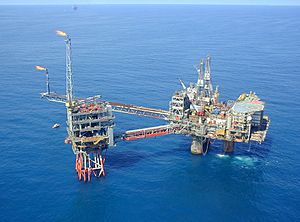
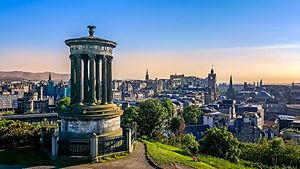
Scotland has a Western-style open mixed economy closely linked with the rest of the UK and the wider world. Traditionally, the Scottish economy was dominated by heavy industry underpinned by shipbuilding in Glasgow, coal mining and steel industries. Petroleum related industries associated with the extraction of North Sea oil have also been important employers from the 1970s, especially in the north-east of Scotland. De-industrialisation during the 1970s and 1980s saw a shift from a manufacturing focus towards a more service-oriented economy.
Scotland's gross domestic product (GDP), including oil and gas produced in Scottish waters, was estimated at £150 billion for the calendar year 2012. In 2014, Scotland's per capita GDP was one of the highest in the EU. As of April 2019 the Scottish unemployment rate was 3.3%, below the UK's overall rate of 3.8%, and the Scottish employment rate was 75.9%.
Edinburgh is the financial services centre of Scotland, with many large finance firms based there, including: Lloyds Banking Group (owners of HBOS); the Government-owned Royal Bank of Scotland and Standard Life. Edinburgh was ranked 15th in the list of world financial centres in 2007, but fell to 37th in 2012, following damage to its reputation, and in 2016 was ranked 56th out of 86. Its status had returned to 17th by 2020.

In 2014, total Scottish exports (excluding intra-UK trade) were estimated to be £27.5 billion. Scotland's primary exports include whisky, electronics and financial services. The United States, Netherlands, Germany, France, and Norway constitute the country's major export markets.
Whisky is one of Scotland's more known goods of economic activity. Exports increased by 87% in the decade to 2012 and were valued at £4.3 billion in 2013, which was 85% of Scotland's food and drink exports. It supports around 10,000 jobs directly and 25,000 indirectly. It may contribute £400–682 million to Scotland, rather than several billion pounds, as more than 80% of whisky produced is owned by non-Scottish companies. A briefing published in 2002 by the Scottish Parliament Information Centre (SPICe) for the Scottish Parliament's Enterprise and Life Long Learning Committee stated that tourism accounted for up to 5% of GDP and 7.5% of employment.
Scotland was one of the industrial powerhouses of Europe from the time of the Industrial Revolution onwards, being a world leader in manufacturing. This left a legacy in the diversity of goods and services which Scotland produces, from textiles, whisky and shortbread to jet engines, buses, computer software, ships, avionics and microelectronics, as well as banking, insurance, investment management and other related financial services. In common with most other advanced industrialised economies, Scotland has seen a decline in the importance of both manufacturing industries and primary-based extractive industries. This has been combined with a rise in the service sector of the economy, which has grown to be the largest sector in Scotland.
Currency
Although the Bank of England is the central bank for the UK, three Scottish clearing banks issue Sterling banknotes: the Bank of Scotland, the Royal Bank of Scotland and the Clydesdale Bank. The issuing of banknotes by retail banks in Scotland is subject to the Banking Act 2009, which repealed all earlier legislation under which banknote issuance was regulated, and the Scottish and Northern Ireland Banknote Regulations 2009.
The value of the Scottish banknotes in circulation in 2013 was £3.8 billion, underwritten by the Bank of England using funds deposited by each clearing bank, under the Banking Act 2009, in order to cover the total value of such notes in circulation.
Military
Of the money spent on UK defence, about £3.3 billion can be attributed to Scotland as of 2013. Although Scotland has a long military tradition predating the Treaty of Union with England, its armed forces now form part of the British Armed Forces, with the exception of the Atholl Highlanders, Europe's only legal private army. In 2006, the infantry regiments of the Scottish Division were amalgamated to form the Royal Regiment of Scotland. Other distinctively Scottish regiments in the British Army include the Scots Guards, the Royal Scots Dragoon Guards and the 154 (Scottish) Regiment RLC, an Army Reserve Regiment of the Royal Logistic Corps.
Because of their topography and perceived remoteness, parts of Scotland have housed many sensitive defence establishments. Between 1960 and 1991, the Holy Loch was a base for the US fleet of Polaris ballistic missile submarines. Today, Her Majesty's Naval Base Clyde, 25 miles (40 kilometres) north-west of Glasgow, is the base for the four Trident-armed Vanguard class ballistic missile submarines that comprise the UK's nuclear deterrent. Scapa Flow was the major Fleet base for the Royal Navy until 1956.
A single front-line Royal Air Force base is located in Scotland. RAF Lossiemouth, located in Moray, is the most northerly air defence fighter base in the United Kingdom and is home to three fast-jet squadrons equipped with the Eurofighter Typhoon.
Culture
Scottish music is a significant aspect of the nation's culture, with both traditional and modern influences. A famous traditional Scottish instrument is the Great Highland Bagpipe, a wind instrument consisting of three drones and a melody pipe (called the chanter), which are fed continuously by a reservoir of air in a bag. Bagpipe bands, featuring bagpipes and various types of drums, and showcasing Scottish music styles while creating new ones, have spread throughout the world. The clàrsach (harp), fiddle and accordion are also traditional Scottish instruments, the latter two heavily featured in Scottish country dance bands. There are many successful Scottish bands and individual artists in varying styles including Annie Lennox, Amy Macdonald, Runrig, Boards of Canada, Cocteau Twins, Deacon Blue, Franz Ferdinand, Susan Boyle, Emeli Sandé, Texas, The View, The Fratellis, Twin Atlantic and Biffy Clyro. Other Scottish musicians include Shirley Manson, Paolo Nutini and Calvin Harris.
Scotland has a literary heritage dating back to the early Middle Ages. The earliest extant literature composed in what is now Scotland was in Brythonic speech in the 6th century, but is preserved as part of Welsh literature. Later medieval literature included works in Latin, Gaelic, Old English and French. The first surviving major text in Early Scots is the 14th-century poet John Barbour's epic Brus, focusing on the life of Robert I, and was soon followed by a series of vernacular romances and prose works. In the 16th century the crown's patronage helped the development of Scots drama and poetry, but the accession of James VI to the English throne removed a major centre of literary patronage and Scots was sidelined as a literary language. Interest in Scots literature was revived in the 18th century by figures including James Macpherson, whose Ossian Cycle made him the first Scottish poet to gain an international reputation and was a major influence on the European Enlightenment. It was also a major influence on Robert Burns, whom many consider the national poet, and Walter Scott, whose Waverley Novels did much to define Scottish identity in the 19th century. Towards the end of the Victorian era a number of Scottish-born authors achieved international reputations as writers in English, including Robert Louis Stevenson, Arthur Conan Doyle, J. M. Barrie and George MacDonald. In the 20th century the Scottish Renaissance saw a surge of literary activity and attempts to reclaim the Scots language as a medium for serious literature. Members of the movement were followed by a new generation of post-war poets including Edwin Morgan, who would be appointed the first Scots Makar by the inaugural Scottish government in 2004. From the 1980s Scottish literature enjoyed another major revival, particularly associated with a group of writers including Irvine Welsh. Scottish poets who emerged in the same period included Carol Ann Duffy, who, in May 2009, was the first Scot named UK Poet Laureate.
As one of the Celtic nations, Scotland and Scottish culture is represented at interceltic events at home and over the world. Scotland hosts several music festivals including Celtic Connections (Glasgow), and the Hebridean Celtic Festival (Stornoway). Festivals celebrating Celtic culture, such as Festival Interceltique de Lorient (Brittany), the Pan Celtic Festival (Ireland), and the National Celtic Festival (Portarlington, Australia), feature elements of Scottish culture such as language, music and dance.
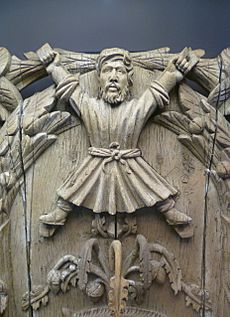
The image of St. Andrew, martyred while bound to an X-shaped cross, first appeared in the Kingdom of Scotland during the reign of William I. Following the death of King Alexander III in 1286 an image of Andrew was used on the seal of the Guardians of Scotland who assumed control of the kingdom during the subsequent interregnum. Use of a simplified symbol associated with Saint Andrew, the saltire, has its origins in the late 14th century; the Parliament of Scotland decreeing in 1385 that Scottish soldiers should wear a white Saint Andrew's Cross on the front and back of their tunics. Use of a blue background for the Saint Andrew's Cross is said to date from at least the 15th century. Since 1606 the saltire has also formed part of the design of the Union Flag. There are numerous other symbols and symbolic artefacts, both official and unofficial, including the thistle, the nation's floral emblem (celebrated in the song, The Thistle o' Scotland), the Declaration of Arbroath, incorporating a statement of political independence made on 6 April 1320, the textile pattern tartan that often signifies a particular Scottish clan and the royal Lion Rampant flag. Highlanders can thank James Graham, 3rd Duke of Montrose, for the repeal in 1782 of the Act of 1747 prohibiting the wearing of tartans.
Although there is no official national anthem of Scotland, Flower of Scotland is played on special occasions and sporting events such as football and rugby matches involving the Scotland national teams and since 2010 is also played at the Commonwealth Games after it was voted the overwhelming favourite by participating Scottish athletes. Other currently less popular candidates for the National Anthem of Scotland include Scotland the Brave, Highland Cathedral, Scots Wha Hae and A Man's A Man for A' That.
St Andrew's Day, 30 November, is the national day, although Burns' Night tends to be more widely observed, particularly outside Scotland. In 2006, the Scottish Parliament passed the St. Andrew's Day Bank Holiday (Scotland) Act 2007, designating the day an official bank holiday. Tartan Day is a recent innovation from Canada.
The national animal of Scotland is the unicorn, which has been a Scottish heraldic symbol since the 12th century.
Scottish music

Scottish music is a significant aspect of the nation's culture, with both traditional and modern influences. A famous traditional Scottish instrument is the Great Highland bagpipe, a wind instrument consisting of three drones and a melody pipe (called the chanter), which are fed continuously by a reservoir of air in a bag. Bagpipe bands, featuring bagpipes and various types of drums, and showcasing Scottish music styles while creating new ones, have spread throughout the world. The clàrsach (harp), fiddle and accordion are also traditional Scottish instruments, the latter two heavily featured in Scottish country dance bands. There are many successful Scottish bands and individual artists in varying styles including Annie Lennox, Amy Macdonald, Runrig, Belle and Sebastian, Boards of Canada, Camera Obscura, Cocteau Twins, Deacon Blue, Franz Ferdinand, Susan Boyle, Emeli Sandé, Texas, The View, The Fratellis, Twin Atlantic and Biffy Clyro. Other Scottish musicians include Shirley Manson, Paolo Nutini, Andy Stewart and Calvin Harris. Scotland hosts several music festivals including the Royal National Mòd and Celtic Connections.
Cuisine
Scottish cuisine has distinctive attributes and recipes of its own but shares much with wider British and European cuisine as a result of local and foreign influences, both ancient and modern. Traditional Scottish dishes exist alongside international foodstuffs brought about by migration.
Scotland's natural larder of game, dairy products, fish, fruit, and vegetables is the chief factor in traditional Scots cooking, with a high reliance on simplicity and a lack of spices from abroad, as these were historically rare and expensive. During the Late Middle Ages and early modern era, French cuisine played a role in Scottish cookery due to cultural exchanges brought about by the "Auld Alliance", especially during the reign of Mary, Queen of Scots.
The national dish of Scotland is haggis, a pudding consisting of sheeps' offal, oatmeal, onion, spices and fat, cooked in a casing. Scotland's national drink is whisky, though Irn-Bru, a popular carbonated soft drink, is often described as "Scotland's other national drink".
Transport

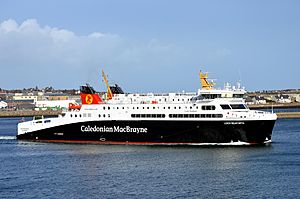
Scotland has five international airports—Aberdeen, Edinburgh, Glasgow, Glasgow Prestwick, and Inverness—operating scheduled services to Europe, North America and Asia, as well domestic services to England, Northern Ireland and Wales. Highlands and Islands Airports operates eleven airports across the Highlands, Orkney, Shetland and the Western Isles, which are primarily used for short distance, public service operations. Edinburgh Airport is currently Scotland's busiest airport handling over 14 million passengers in 2018.
Network Rail owns and operates the fixed infrastructure assets of the railway system in Scotland, while Transport Scotland retains overall responsibility for rail strategy and funding in Scotland. Scotland's rail network has around 350 railway stations and 3,000 kilometres (1,900 mi) of track, a decline of over one-third since the mid-twentieth century.
The Scottish motorways and major trunk roads are managed by Transport Scotland, while the remainder of the road network is managed by local authorities. Bus transport was privatized in the 1980s.
Regular ferry services operate between the Scottish mainland and outlying islands. Ferries serving both the inner and outer Hebrides are principally operated by the state-owned enterprise Caledonian MacBrayne. Services to the Northern Isles are operated by Serco. Other routes, served by multiple companies, connect southwest Scotland to Northern Ireland. Additional routes are operated by local authorities.
Sport
Scotland hosts its own national sporting competitions and has independent representation at several international sporting events, including the FIFA World Cup, the Rugby Union World Cup, the Rugby League World Cup, the Cricket World Cup, the Netball World Cup and the Commonwealth Games. Scotland has its own national governing bodies, such as the Scottish Football Association (the second oldest national football association in the world) and the Scottish Rugby Union. Variations of football have been played in Scotland for centuries, with the earliest reference dating back to 1424.
Football
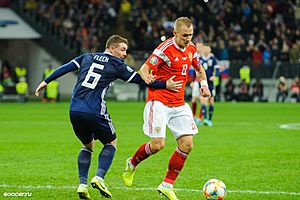
The world's first official international association football match was held in 1872 and was the idea of C. W. Alcock of the Football Association which was seeking to promote Association Football in Scotland. The match took place at the West of Scotland Cricket Club's Hamilton Crescent ground in the Partick area of Glasgow. The match was between Scotland and England and resulted in a 0–0 draw. Following this, the newly developed football became the most popular sport in Scotland. The Scottish Cup was first contested in 1873. Queen's Park F.C., in Glasgow, is probably the oldest association football club in the world outside England.
The Scottish Football Association (SFA), the second-oldest national football association in the world, is the main governing body for Scottish association football, and a founding member of the International Football Association Board (IFAB) which governs the Laws of the Game. As a result of this key role in the development of the sport Scotland is one of only four countries to have a permanent representative on the IFAB; the other four representatives being appointed for set periods by FIFA.
The SFA also has responsibility for the Scotland national football team, whose supporters are commonly known as the "Tartan Army". As of December 2019[update], Scotland are ranked as the 50th best national football team in the FIFA World Rankings. The national team last attended the World Cup in France in 1998, but finished last in their group stage. The Scotland women's team have achieved more recent success, qualifying for both Euro 2017 and the 2019 World Cup. As of December 2019[update], they were ranked as the 22nd best women's national team in the FIFA Rankings.
Scottish clubs have achieved some success in European competitions, with Celtic winning the European Cup in 1967, Rangers and Aberdeen winning the UEFA Cup Winners' Cup in 1972 and 1983 respectively, and Aberdeen also winning the UEFA Super Cup in 1983. Celtic, Rangers and Dundee United have also reached European finals, the most recent of these being Rangers in 2008.
Golf
With the modern game of golf originating in 15th-century Scotland, the country is promoted as the home of golf. To many golfers the Old Course in the Fife town of St Andrews, an ancient links course dating to before 1552, is considered a site of pilgrimage. In 1764, the standard 18-hole golf course was created at St Andrews when members modified the course from 22 to 18 holes. The world's oldest golf tournament, and golf's first major, is The Open Championship, which was first played on 17 October 1860 at Prestwick Golf Club, in Ayrshire, Scotland, with Scottish golfers winning the earliest majors. There are many other famous golf courses in Scotland, including Carnoustie, Gleneagles, Muirfield, and Royal Troon.
Other sports
Other distinctive features of the national sporting culture include the Highland games, curling and shinty. In boxing, Scotland has had 13 world champions, including Ken Buchanan, Benny Lynch and Jim Watt. Scotland has also been successful in motorsport, particularly in Formula One. Notable drivers include; David Coulthard, Jim Clark, Paul Di Resta, and Jackie Stewart. In IndyCar, Dario Franchitti has won 4 consecutive IndyCar world championships.
Scotland has competed at every Commonwealth Games since 1930 and has won 356 medals in total—91 Gold, 104 Silver and 161 Bronze. Edinburgh played host to the Commonwealth Games in 1970 and 1986, and most recently Glasgow in 2014.
Education
The Scottish education system has always been distinct from the rest of the United Kingdom, with a characteristic emphasis on a broad education. In the 15th century, the Humanist emphasis on education cumulated with the passing of the Education Act 1496, which decreed that all sons of barons and freeholders of substance should attend grammar schools to learn "perfyct Latyne", resulting in an increase in literacy among a male and wealthy elite. In the Reformation, the 1560 First Book of Discipline set out a plan for a school in every parish, but this proved financially impossible. In 1616 an act in Privy council commanded every parish to establish a school. By the late seventeenth century there was a largely complete network of parish schools in the lowlands, but in the Highlands basic education was still lacking in many areas. Education remained a matter for the church rather than the state until the Education (Scotland) Act 1872.
The Curriculum for Excellence, Scotland's national school curriculum, presently provides the curricular framework for children and young people from age 3 to 18. All 3- and 4-year-old children in Scotland are entitled to a free nursery place. Formal primary education begins at approximately 5 years old and lasts for 7 years (P1–P7); children in Scotland study Standard Grades, or Intermediate qualifications between the ages of 14 and 16. These are being phased out and replaced by the National Qualifications of the Curriculum for Excellence. The school leaving age is 16, after which students may choose to remain at school and study for Access, Intermediate or Higher Grade and Advanced Higher qualifications. A small number of students at certain private, independent schools may follow the English system and study towards GCSEs and A and AS-Levels instead.
There are fifteen Scottish universities, some of which are amongst the oldest in the world. The four universities founded before the end of the 16th century – the University of St Andrews, the University of Glasgow, the University of Aberdeen and the University of Edinburgh – are collectively known as the ancient universities of Scotland, all of which rank among the 200 best universities in the world in the THE rankings, with Edinburgh placing in the top 50. Scotland had more universities per capita in QS' World University Rankings' top 100 in 2012 than any other nation. The country produces 1% of the world's published research with less than 0.1% of the world's population, and higher education institutions account for 9% of Scotland's service sector exports. Scotland's University Courts are the only bodies in Scotland authorised to award degrees.
Tuition is handled by the Student Awards Agency Scotland (SAAS), which does not charge fees to what it defines as "Young Students". Young Students are defined as those under 25, without children, marriage, civil partnership or cohabiting partner, who have not been outside of full-time education for more than three years. Fees exist for those outside the young student definition, typically from £1,200 to £1,800 for undergraduate courses, dependent on year of application and type of qualification. Postgraduate fees can be up to £3,400. The system has been in place since 2007 when graduate endowments were abolished. Labour's education spokesperson Rhona Brankin criticised the Scottish system for failing to address student poverty.
Scotland's universities are complemented in the provision of Further and Higher Education by 43 colleges. Colleges offer National Certificates, Higher National Certificates, and Higher National Diplomas. These Group Awards, alongside Scottish Vocational Qualifications, aim to ensure Scotland's population has the appropriate skills and knowledge to meet workplace needs. In 2014, research reported by the Office for National Statistics found that Scotland was the most highly educated country in Europe and among the most well-educated in the world in terms of tertiary education attainment, with roughly 40% of people in Scotland aged 16–64 educated to NVQ level 4 and above. Based on the original data for EU statistical regions, all four Scottish regions ranked significantly above the European average for completion of tertiary-level education by 25- to 64-year-olds.
Kilmarnock Academy in East Ayrshire is one of only two schools in the UK, and the only school in Scotland, to have educated two Nobel Prize Laureates – Alexander Fleming, discoverer of Penicillin, and John Boyd Orr, 1st Baron Boyd-Orr, for his scientific research into nutrition and his work as the first Director-General of the United Nations Food and Agriculture Organization (FAO).
Infrastructure
Energy
Scotland's primary sources for energy are provided through renewable energy (61,8%), nuclear (25.7%) and fossil fuel generation (10.9%).
In Scotland, 98.6% of all electicity used was from renewable sources. This is minus net exports.
The Scottish Government has a target to have the equivalent of 50% of the energy for Scotland's heat, transport and electricity consumption to be supplied from renewable sources by 2030.
Transport
Air
Scotland has five international airports operating scheduled services to Europe, North America and Asia, as well as domestic services to England, Northern Ireland and Wales.
Highlands and Islands Airports operates eleven airports across the Highlands, Orkney, Shetland and the Western Isles, which are primarily used for short distance, public service operations, although Inverness Airport has a number of scheduled flights to destinations across the UK and mainland Europe.
Edinburgh Airport is currently Scotland's busiest airport handling over 13 million passengers in 2017. It is also the UK's 6th busiest airport.
British Airways, easyJet, flybe, Jet2, and Ryanair operate the majority of flights between Scotland and other major UK and European airports.
Four airlines are based in Scotland:
- Directflight
- Hebridean Air Services
- Loch Lomond Seaplanes
- Loganair
Rail
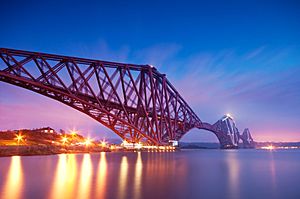
Network Rail owns and operates the fixed infrastructure assets of the railway system in Scotland, while the Scottish Government retains overall responsibility for rail strategy and funding in Scotland. Scotland's rail network has 359 railway stations and around 1,710 miles (2,760 km) of track. In 2018–19 there were 102 million passenger journeys on Scottish railways.
The East Coast and West Coast main railway lines connect the major cities and towns of Scotland with each other and with the rail network in England. London North Eastern Railway provides inter-city rail journeys between Glasgow, Edinburgh, Aberdeen and Inverness to London. Domestic rail services within Scotland are operated by ScotRail. During the time of British Rail, the West Coast Main Line from London Euston to Glasgow Central was electrified in the early 1970s, followed by the East Coast Main Line in the late 1980s. British Rail created the ScotRail brand. When British Rail existed, many railway lines in Strathclyde were electrified. Strathclyde Passenger Transport Executive was at the forefront with the acclaimed "largest electrified rail network outside London". Some parts of the network are electrified, but there are no electrified lines in the Highlands, Angus, Aberdeenshire, the cities of Dundee or Aberdeen, or Perth & Kinross, and none of the islands has a rail link (although the railheads at Kyle of Lochalsh and Mallaig principally serve the islands).
The East Coast Main Line crosses the Firth of Forth by the Forth Bridge. Completed in 1890, this cantilever bridge has been described as "the one internationally recognised Scottish landmark". Scotland's rail network is managed by Transport Scotland.
Road
The Scottish motorways and major trunk roads are managed by Transport Scotland. The remainder of the road network is managed by the Scottish local authorities in each of their areas.
Water
Regular ferry services operate between the Scottish mainland and outlying islands. Ferries serving both the inner and outer Hebrides are principally operated by the state-owned enterprise Caledonian MacBrayne.
Services to the Northern Isles are operated by Serco. Other routes, served by multiple companies, connect southwest Scotland to Northern Ireland. DFDS Seaways operated a freight-only Rosyth – Zeebrugge ferry service, until a fire damaged the vessel DFDS were using. A passenger service was also operated between 2002 and 2010.
Additional routes are operated by local authorities.
-
Air Traffic Control tower of Edinburgh Airport, Scotland's busiest airport by passenger numbers
-
Domestic rail services are operated by ScotRail.
-
The M8 motorway is the busiest motorway in Scotland, running from Glasgow to Edinburgh
Images for kids
-
The exposed interior of a house at Skara Brae
-
The Wallace Monument commemorates William Wallace, the 13th-century Scottish hero.
-
The National Monument of Scotland on Calton Hill in Edinburgh is the national memorial to Scottish soldiers lost in the Napoleonic Wars
-
Douglas Haig and Ferdinand Foch inspecting the Gordon Highlanders, 1918
-
Rudolf Hess, Deputy Führer of Nazi Germany, crashed his plane at Bonnyton Moor in the Scottish central belt in an attempt to make peace.
-
The official reconvening of the Scottish Parliament in July 1999 with Donald Dewar, then first minister of Scotland (left) with Queen Elizabeth II (centre) and Presiding Officer Sir David Steel (right)
-
Iona in the Inner Hebrides
-
The Scottish Highlands, located in the north and west of Scotland
-
Tiree in the Inner Hebrides is one of the sunniest locations in Scotland
-
Red deer stag with velvet antlers in Glen Torridon
-
Iona Abbey, an early centre of Christianity in Scotland
-
The Bank of Scotland has its headquarters in Edinburgh and is one of the oldest operating banks in the world.
-
Type 45 destroyer HMS Daring (D32) was constructed at BAE Systems Maritime – Naval Ships, Glasgow
-
Scottish inventor John Logie Baird demonstrated the first working television system on 26 January 1926.
See also
 In Spanish: Escocia para niños
In Spanish: Escocia para niños




